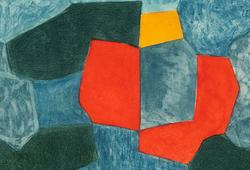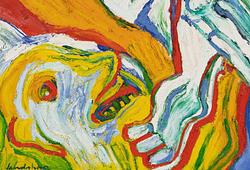Carl Fredrik Hill
Palace interior with a rearing horse
Ink on paper, image area 56 x 66 cm.
Saleroom notice
Litteratur: Nils Lindhagen, "Carl Fredrik Hill. Sjukdomsårens konst", 1976, upptagen i katalogen som nr 241 "Till häst".
Provenance
According to information given, acquired at Stockholms Auktionsverk in 1958.
Thence by descent.
Literature
Nils Lindhagen, "Carl Fredrik Hill. Sjukdomsårens konst", 1976, listed in the catalogue as no. 241 "Till häst" (On horseback).
More information
A theme that fascinated Carl Fredrik Hill during his period of illness was the historical "triumph," which he often placed within an impressive architectural setting. The auction's drawing of a palace interior with a rearing horse is inspired by the highest triumph of Swedish independence: Sten Sture's victory in the Battle of Brunkeberg. According to Lindhagen, Hill drew his main figure from C.G. Hellqvist's version of Sten Sture, depicted in "Förr och Nu 1874 - illustrated reading for the home."
Hill's period of illness lasted for over thirty years. He was cared for in his childhood home with access to his late father's extensive library, which contained all the inspiration the artist could possibly need. The so-called architectural "karduser" from the 1890s constitute one of the most comprehensive projects in Hill's output from this time. Hill drew with iron gall ink on the common brown wrapping paper of the day (kardus paper). In these vast temple and palace interiors unfolds the eternal, unresolved struggle between good and evil. In terms of size, these are the largest of Hill's preserved drawings.
In the grand interior of the current drawing, we are met by a throng of figures: people, fantastical creatures, dancing horses, bearded prophets, and warriors grouped in fives. In the niches stand contorted figures from the world of saints, the walls adorned with friezes of fantastical animals, and above the arches are figures cowering before God. In the midst of this disarray, the "Saviour" rears up on horseback, and just behind him is a mysterious figure reminiscent of pharaonic imagery. Hill has depicted the rearing horse with dense bundles of parallel lines to emphasise the animal's powerful body. According to his own talismanic rules, he has grouped these lines in the significant number five.
In several other so-called "karduser - drawings," the same parallel line technique appears to underscore power and strength, including in "Charlemagne grants protection." The number five is also manifested in the number of ships, windows, and muntins in the interiors. Multiples of five, and also three, proliferate almost manically throughout the motifs.
Carl Fredrik Hill's later production from his period of illness has subsequently been assigned significant art historical value and is regarded as groundbreaking for the development of modern expression in art.
Artist
Carl Fredrik Hill was a Swedish artist born in Lund. Hill is considered one of Sweden's formost landscape painters. His fate and artistry are perhaps the strangest but most interesting in Swedish art history. Born in an academic home in Lund, despite his father's protests, he managed to begin studies at the Art Academy in Stockholm and then traveled to France, where he came in contact with Corot's landscape painting. He found his inspiration in Barbizon and later on the River Oise, in Luc-sur-Mer and Bois-le-Roi. He painted frantically with the hope of being accepted into the Salon de Paris. Already during his student years, he struggled with an incipient mental illness and at the age of 28 he was taken to the mental hospital in Passy. During the hospital stay he began his rich production of drawings and then continued with the production after his return to Lund, where he was cared for by his family for the rest of his life. In thousands drawings, a fantasy world of figures scenes appears. Today, Hill's river landscape and flowering fruit trees from the years in France, together with the visionary drawings from the period of illness in Lund, have received great recognition. His art depicts a loneliness and longing that is easy to get caught up in. He is mainly represented at the Malmö Museum and at the National Museum in Stockholm.
Read more






























































